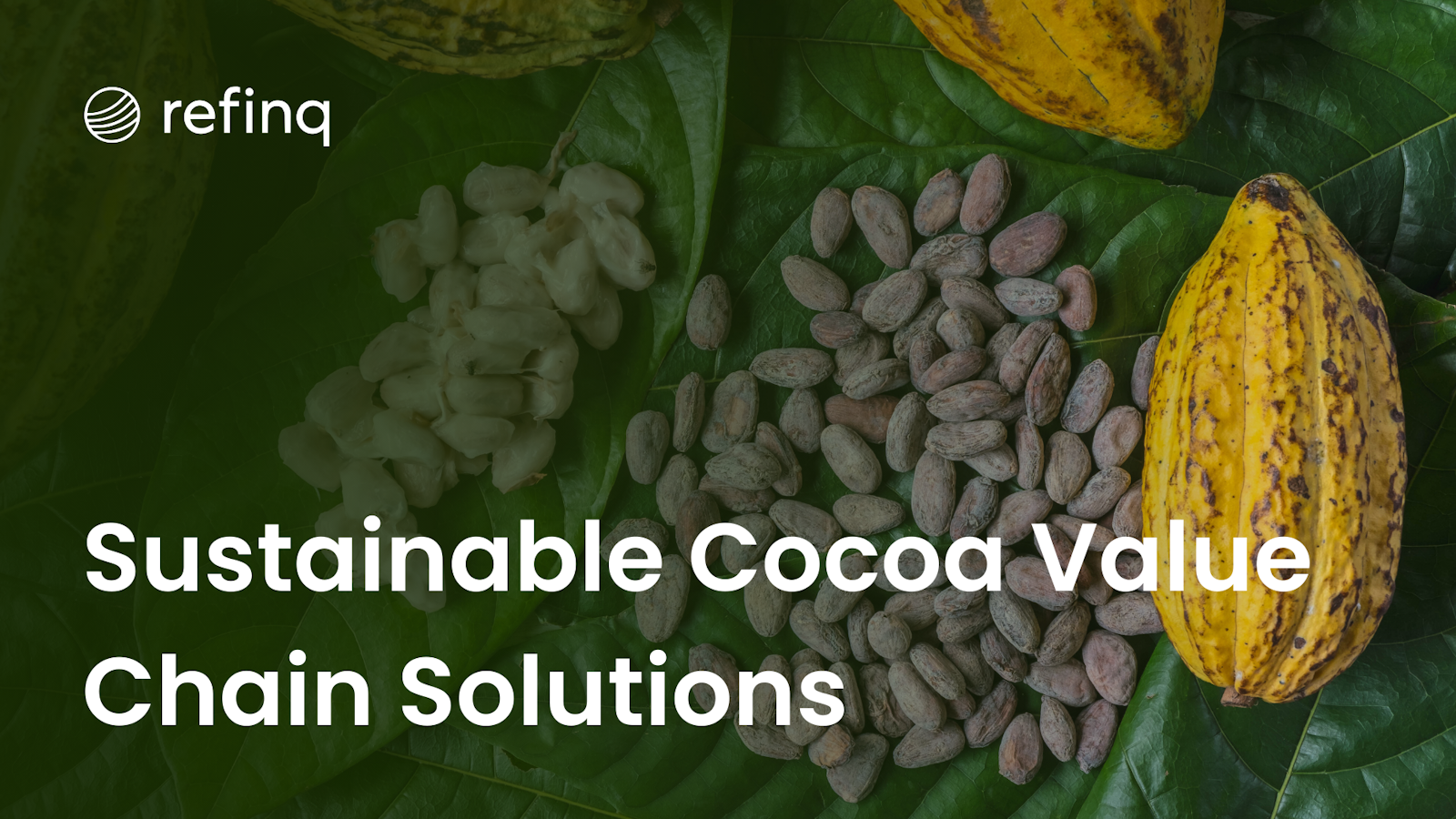

In cocoa production, biodiversity is essential for sustainable agricultural systems. Traditional cocoa farming often involves intensive land use, chemical inputs, and deforestation, impacting the environment. The cocoa value chain—from growing to distribution—affects ecosystems significantly. Building a biodiversity-rich cocoa value chain supports a sustainable future, fostering resilience in ecosystems and economies. Companies like Blue Stripes are establishing sustainable practices in the cocoa supply chain, advancing environmental stewardship.
Investing in biodiversity benefits farmers, communities, and the environment. Tools like refinq help businesses manage environmental risks, aligning practices with economic and ecological goals. Refiq provides real-time biodiversity risk assessments, helping cocoa producers make informed decisions that protect ecosystems.
Understanding Biodiversity in the Cocoa Value Chain
Biodiversity in cocoa includes plant, animal, and microbial communities that support sustainable farming by enhancing soil health, pest control, and climate resilience. World Agroforestry offers guidelines for maintaining biodiversity, while refinq provides data-driven assessments.
Biodiversity benefits cocoa production by improving soil health, providing natural pest control, and enhancing the crop's adaptability to climate changes. By fostering a biodiverse environment, cocoa farmers can reduce their reliance on chemical inputs, improve crop quality, and ensure a stable yield. Moreover, biodiversity contributes to ecosystem services that support the long-term viability of cocoa farming, making it a valuable asset for sustainability.
Biodiversity also enhances cocoa production through improved pollination and ecosystem health. Research indicates that manual pollination can significantly boost cocoa yields. A study analyzing data from over 150,000 cocoa farms found that manual pollination could triple farm yields and double farmers' annual profits in major producer countries like Ivory Coast, Ghana, and Indonesia. This approach has the potential to increase global cocoa supplies by up to 13%. These findings highlight how biodiversity-focused practices can not only support ecosystem resilience but also significantly improve cocoa productivity and farmer incomes.
Monoculture cocoa farms limit ecological diversity, making crops more vulnerable to pests. In contrast, biodiversity-focused systems build ecosystem resilience. refinq’s Portfolio Impact Assessment assists producers in managing biodiversity risks linked to monoculture practices.
Cocoa farming expansion often leads to deforestation, impacting biodiversity. Global Landscapes Forum highlights balancing cocoa production with habitat conservation, and refinq’s Climate Solutions help address these issues.
Fertilizers and pesticides harm biodiversity by disrupting soil ecosystems and affecting species. MDPI offers insights into sustainable practices to reduce chemical use, aligning with refinq’s Footprinting tools for environmental impact assessment.
Agroforestry combines cocoa with other plants, creating a biodiverse environment that supports wildlife and stabilizes soil. Barry Callebaut and refinq’s Benchmarking Tools support agroforestry’s biodiversity benefits.
Shade-grown cocoa, cultivated under canopies, preserves biodiversity by supporting pollinators and soil health. The Biodiversa+ Cocoa Initiative endorses this practice, and refinq’s Due Diligence enables producers to assess its biodiversity benefits.
Regenerative agriculture restores soil health, conserves water, and enhances resilience. Practices like composting, minimal tillage, and crop rotation help reverse soil degradation, benefiting both cocoa production and biodiversity.
Biodiversity corridors connect habitats, supporting wildlife movement and genetic diversity. Think Landscape explores buffer zone benefits, while refinq assists in assessing their environmental impact.
Cocoa-producing regions often house unique species facing habitat loss. Conservation efforts focus on protecting these species, crucial for biodiversity. Collaborative projects like the Biodiversa+ Cocoa Initiative play a key role.
Sustainable water and soil management protect biodiversity in cocoa landscapes. Montana State University supports sustainable practices, aligning with refinq’s Climate Tools for managing biodiversity risks.
Farmers, companies, and consumers all contribute to biodiversity in cocoa production. Farmers apply biodiversity-focused practices, companies provide resources, and consumers drive demand for sustainable cocoa.
Partnerships with conservation organizations strengthen biodiversity efforts, helping producers adopt eco-friendly practices, as shown in Barry Callebaut's Sustainable Cocoa Strategies.
Programs like Fairtrade and Rainforest Alliance promote habitat conservation, reduce chemical use, and encourage sustainable practices in cocoa production.
Biodiverse cocoa value chains support soil health, water conservation, and resilience to climate changes. Diverse ecosystems adapt better to environmental shifts, stabilizing cocoa production, supported by refinq’s Biodiversity Solutions.
Biodiversity-friendly practices reduce chemical reliance and improve crop resilience, lowering costs and boosting profitability. This aligns with Blue Stripes’ sustainable cocoa model.
Biodiversity-friendly practices reduce chemical exposure, support local economies, and enhance food security and quality of life for cocoa-growing communities.
Cocoa producers adopting agroforestry show positive results, as seen in regions following the World Agroforestry Cocoa Roadmap. These practices offer valuable insights.
Regions like Ghana and Côte d'Ivoire implement biodiversity initiatives, protecting habitats while supporting cocoa production. These projects illustrate effective biodiversity management.
Practices from crops like coffee and palm oil provide valuable lessons for cocoa producers. Similar biodiversity-friendly practices can enhance sustainability in cocoa.
Implementing biodiversity practices requires investment, challenging for small-scale farmers. Financial incentives and support programs encourage sustainable adoption.
Training programs help farmers adopt biodiversity practices. Knowledge-sharing platforms enable effective biodiversity-focused methods.
Government policies and incentives are crucial for promoting biodiversity-friendly practices, addressing financial and logistical challenges in cocoa farming.
refinq provides advanced tools for biodiversity and climate risk assessments. Through data-driven insights, refinq helps cocoa producers manage environmental risks, aligning operations with biodiversity goals and supporting sustainable cocoa production.
refinq’s tools for biodiversity risk assessment and adherence to global standards enable accurate environmental risk evaluation. Integrating refinq’s insights, companies can enhance biodiversity, improve compliance, and implement nature-positive strategies.
Prioritizing biodiversity in the cocoa value chain is essential for a sustainable, resilient industry. Biodiversity-focused practices enhance environmental health, economic stability, and social well-being. By leveraging tools like refinq and sustainable methods, the cocoa industry can positively impact the environment and local communities.
Global Landscapes Forum: How to Boost the Sustainability of Cocoa Value Chains
Montana State University: Nigeria Sustainable Cocoa Value Chain